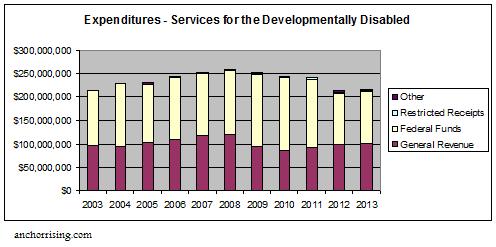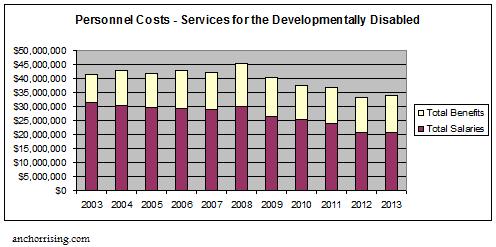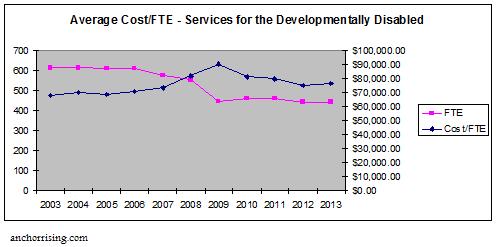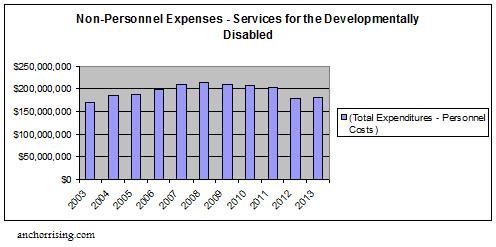Explaining the Cuts to Services for Developmentally Disabled
Bob Kerr writes about cuts to programs for developmentally disabled people in Sunday’s ProJo. My wife worked for some years with adults in this population and I’m aware of the importance of the programs that these individuals and their families rely upon. I also appreciate that they are going to go to great lengths to restore or save these programs. Kerr provides a few examples of the cuts that have been enacted and he quotes the father of one client, Brian Newton:
“I don’t think anyone expected the severity of the cuts,” says Newton, who attended the rally and has been a strong and consistent voice for the disabled. “Since 2003, there has been no budget increase. And in 2008, they started with the cuts. There has been 38 percent in cuts overall.”
Well, that piqued my interest. I had a hard time believing there had been no budget increase since 2003. After a review of the “Services for Developmentally Disabled” included in state budgets since 2003, it’s readily apparent that, in fact, there have been several budget increases for those programs since that time.

In fact, what has happened is that the programs were funded at around $213 million in 2003 and they were funded at about the same level in 2012 (actually, about a 1% increase). But in between, the funding rose and fell, with the fall coming after the recession hit full force in 2008. That’s not “level funded”, per se. It is true that since 2008 funding has decreased, but by around 19%, not 38%. (However, Newton may be talking about a specific program and not the overall budget).
Digging deeper, personnel costs hung around in the $40-45 million range until 2008, when the recession hit, and have decreased ever since (though Governor Chafee’s 2013 budget proposes an increase).

The total number of positions funded (FTE’s) hung around 612 from 2003 to 2007, when there was a cut of 35 positions, then another 20 were cut in 2008. However, 2009 saw yet another cut of around 90 positions and, since then, there have been around 445-460 positions funded. And while the number of positions declined, the cost/position (salary + benefits) trended upward.

There is a distinct demarcation line in 2009. In that year, when the number of jobs were cut the most, the cost/FTE was at it’s largest ($90,500); perhaps some legacy overhead costs? Since then, while the number of funded FTE’s has remained relatively stable, the cost/FTE has slowly declined (though Governor Chafee’s budget results in a slight increase). Yet, overall, while the cost/FTE was $67,700 in 2003 it was $75,000 in 2012. That includes roughly a 29% increase in the cost of benefits (particularly health care and pensions) since 2003.
Taking out personnel costs, we see that $170.8 million was spent in 2003 while $180.3 million is budgeted in 2013 (a 5.5% increase). However, the high mark was $213.8 million in 2008, which means, since then, funding for non-personnel related expenditures has dropped nearly 16%.

As the above charts show, costs have basically returned to 2003 levels after rising and then falling. As Kerr’s article points out, people feel that services are being cut and it is particularly manifested in the loss of personnel. Even at the return to 2003 funding levels, the number of personnel–boots on the ground–has declined from 613 people to 443 today and, overall, personnel costs have declined from $41.5 million to $33.8 million. Yet, they cost more to employ (about
What is the solution? I honestly don’t know. Tax increases, if what we’re told is true, are a non-starter in the General Assembly. Perhaps a consolidation of services between the various local entities could help with the overhead. Or maybe advocates should help the General Assembly see that a re-prioritization of what we’re spending money on is needed. They could also find other areas of the budget to cut or think of ways to save more money in their own budget.

“Or maybe advocates should help the General Assembly see that a re-prioritization of what we’re spending money on is needed.”
I’m not an advocate but to me, this is a no-brainer. Resources to our most vulnerable citizens should never have been cut.
The $24 million needs to be restored in full. With these cuts, the G.A. and the Governor showed themselves and, by extension, the state as a whole, to have entirely the wrong priorities.
I think the correct way to measure these things would not be ‘real dollars’, but inflation-adjusted ones, no?
Also, a more liberal interpretation would be to measure them as a portion of the state’s annual GDP.
RI is the anti-Darwin state-the least productive people are catered to while the most productive are persecuted and treated like Kulaks in the Ukraine circa 1930.
Obviously the retarded are non-productive through no fault of their own. The same can NOT be said of the illegal aliens, welfare/disability crooks, cronies, hacks and union pigs, and make no mistake the drive to restore these cuts is not so much about the retarded but the unionists who profit from them. The same conundrum which exists in the failed public schools.
mangeek, I don’t think inflation adjusted is relevant–the entire budgeting process (taken as a self-contained entity) has the same constant “variable” of inflation to deal with (including cost to employ). It doesn’t matter why costs to employ have increased, only the reality that they have. It is what it is, as they say. For me, it’s more about (especially) budget priorities.